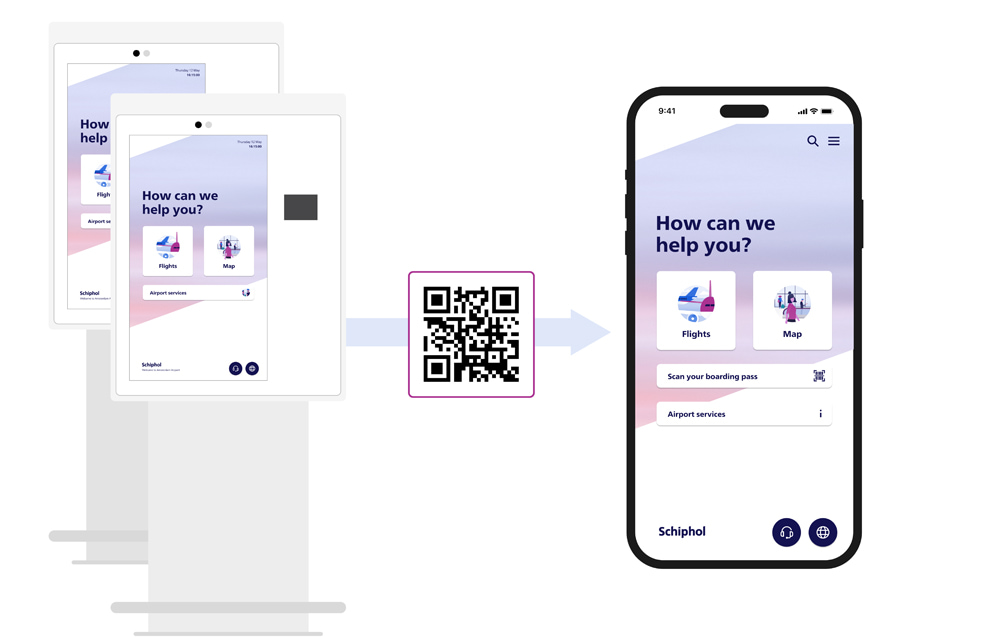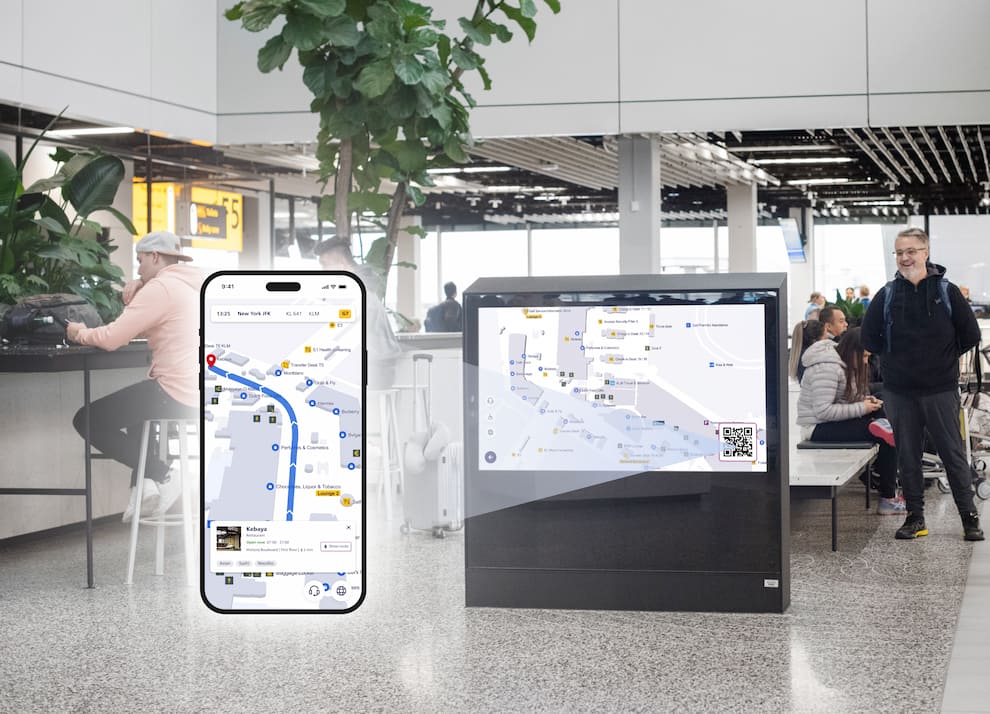Increase CSAT scores and drive airport revenue
When Tijn Borms, Director of Product, saw passengers taking pictures of the information on the Self-Service Units (SSU) it triggered the creation of making the platform available on a mobile device. This ‘move to mobile’ has created many new possibilities and it will significantly increase the reach.

In short:
- The move to mobile, allows passengers to access the platform seamlessly from their devices, enhancing passenger experience and reach.
- The new mobile capabilities aim to strike a 50-50 balance between improving passenger experience and unlocking commercial opportunities for airports.
- New capabilities include notifications, personal itineraries, commercial offerings.
Can you explain what the move to mobile means?
This means that passengers can seamlessly move from the SSU to their mobile device. Whatever they were doing on the kiosk, they can continue doing while on the go. It’s essentially putting all the features of the SSU in their pocket. For example, if a passenger has scanned their boarding pass on the kiosk to retrieve their flight information, they can take this information ‘with them’ by scanning a QR code. They no longer need to take a picture of the screen of the SSU. In turn this will not generate more sessions, but it will create more opportunities for airports to interact with the passengers.
And, since the platform is built on mobile technology, we thought to ourselves: 'Why should passengers access it through a kiosk to begin with?'. That’s why we’ve also made it possible for passengers to scan a QR code throughout the terminal to reach the platform. Anyone who needs help can access it directly as a mobile webpage.
Anyone, also passengers with reduced mobility ?
The move to mobile is the starting point for many different use cases. We are planning to also support passengers with reduced mobility (PRM) with the platform. PRM pillars can be found throughout the terminal, but in the future people can use the mobile platform capabilities to get support. For example, people with hearing aids can already connect these to their mobile phones, it would therefore make sense to make it easy for them to use our platform to speak to an agent. That’s much more comfortable compared to having to talk to an agent through a speaker.
So, essentially, passengers can move from the SSU to the mobile platform but they can also only use the mobile platform?
Yes. It’s two different use cases with the same platform.
Passengers who have started a video call on the SSU with a support agent can transfer the call to their mobile device for a more private chat, or if they need to start walking to their gate. They are essentially continuing their session on a mobile device.
Passengers can also enter the platform from a mobile device as a starting point. A QR code or simple URL next to an airport map (or any other point of interest, e.g. prayer room, tax return office, restaurant, store, etc.) in the terminal can help passengers to take the map with them.

What triggered the creation of the new mobile capabilities of the platform?
There were multiple drivers. We often walk around the terminal and always see people taking photos of what’s on the SSU. And, from a technology perspective, it’s strange that the platform is built using web technology but that it wasn’t available on a mobile device. What also influenced the decision is the input from airports. For example, small airports which are easy to navigate have different requirements compared to large ones. Now the platform can be configured to match specific use cases.
And why now?
When I looked at the technology and user needs, I strongly felt this is something we must do. Also, it wasn't a huge project because of how the technology was built but it delivers a significant improvement for passengers and airports who use it. It's becoming really exciting now because we're iterating on it. It was mainly very logical to do. In hindsight we should have done this a lot earlier!
Why didn’t you?
I think it took us some time to realise this need existed. The SSU were the solution to the problem ‘We don’t have manned information zones anymore’. They were created to find an alternative to the desk where people would go to with questions. At that time, the much wider platform vision didn't exist. Maybe we needed that intermediate step to see that this was the user's need. It also fits with our way of working where we use qualitative and quantitative data to improve the platform. Since multiple airports use the SSU and the platform, it accelerates our development as it generates more data and insights.

Airports want to improve the passenger experience but also create commercial opportunities. Where do these new capabilities focus on.
They focus on both, exactly 50-50 I’d say. The move to mobile is mainly there to make the platform more accessible.
It helps us to reach more people, and to reach them for a longer time. It creates more opportunities for airports to help them when they need assistance and more time to get to know the passenger. This will be important to offer them something commercially interesting.
What’s the difference between the mobile platform and the airport app?
They complement each other. As Schiphol, we don't reach 100% of passengers. We capture a piece of reach on all of the different channels. The beauty of a platform is that all traffic it gets is from people who are actually at the terminal. Its use case is focused on airport passengers only. All content and features can be tailored to them. The airport website and the airport app are channels which are also used by people who are not yet at the actual airport. In some cases the app isn’t even used by passengers but by people dropping them off or picking them up. From research we know that taxi drivers also frequently use the app.
Also, it’s hard for airports to get passengers to download an app. In Schiphol’s case, Dutch residents and frequent flyers might install the app but people who will not visit Schiphol in the near future won't download an app. Also, about half of the passengers at Schiphol are transferring passengers.
They are really two different channels and airports can increase the absolute reach if they use both.
Interesting what you said about the platform reaching only passengers in the terminal. How does this help unlock commercial opportunities for airports?
Since the channel is entirely focused on passengers at the terminals it’s interesting from a commercial perspective because you can be very specific to what you share with your audience. We’re also working on making the unknown travellers known to us. We can then offer even more targeted information like vouchers, relevant shops and interesting experiences. We’ve already launched the personal itinerary feature which we can then make even more specific. We are currently running multiple pilots to understand how we can seize those opportunities.
What's next?
Making the unknown passenger known is high on the list of to-do’s. It also allows us to start sending notifications and use communication channels like WhatsApp, Facebook Messenger and similar ones. Even though the platform is in the passengers pocket now, it is still reactive. Going forward we will make it a pro-active platform by sending notifications based on the passengers' personal itinerary. For example, if you've already requested your itinerary on the SSU, you will be able to request updates based on it, enter your phone number, and then you'll get updates about the flight. These updates contain a link to the mobile version, which brings you back to the platform and can be converted into a commercial opportunity. Such as shopping, if the person has a lot of time until the flight.
Let’s say a flight has a three-hour delay, we can then send a message along the lines of “We’re sorry about the delay, here’s a voucher for X, hope this make your wait a little bit more pleasant.” We can also segment by destination typical holiday destinations have a different profiles. In case of a very short layover, airports can use the platform to help passengers make it to their flight on time, by sending focused notifications about walking times, reminders and gate changes.

You’re creating a profile based on phone numbers?
So far, creating a user profile is often been based on an email address or social media account but a phone number works just as good. Perhaps even better in the airport’s case. Especially because it's about notifications, we want to move toward a conversational user interface, enriched by AI. In the earlier example about sending a voucher in case of a flight delay, we could send a message like: "Hey John, your flight is delayed, can we do something cool for you?”, and engage in a conversation.
Is there a difference between sending messages to a mobile phone number and using emails?
Yes, that’s another argument to use phone numbers. Conversion of SMS and instant messaging is a lot higher compared to email. But there’s a flip side to it, too. Commercial messages on mobile phones will be seen as intrusive a lot quicker on a mobile phone compared to an email. Airports have to be careful in how they use this channel.
Talking about conversions, you and I had one about pushing the platform onto the WiFi login page as an alternative to the often seen banner ads. Care to explain?
Well, for airports, the WiFi page is an interesting topic for debate. The WiFi portal has a large reach at every airport. Do you charge for it or provide it free of charge? Do you show banners on it to drive revenue? Convert unknown to known passengers?
Many times there is a, if you ask me, superficial contradiction between boosting passenger experience and increasing revenue. Research shows they go hand in hand. Take one of the conclusions of the Airport Service Quality Survey 2021 by ACI; “A 1% increase in passenger satisfaction generates an average 1.5% growth in non-aeronautical revenue”. This says it all; by focusing only on one of them you’re missing out on the synergy that can be created by focusing on both. There is an indirect monetary value in focusing on passenger experience, period. In the end it is simple math; leveraging the WiFi platform boosts the reach of the passenger experience platform, boosting its impact on passenger experience, boosting the indirect effect on non-aeronautical revenue.
A 1% increase in passenger satisfaction generates an average 1.5% growth in non-aeronautical revenue
And you can boost it even more when you mix revenue drivers in a smart way by adding value to the passenger. Airports can add value and get to know the passenger in return. Oh, and did I mention NPS? The mobile version of our platform can be configured as the WiFi portal and then start doing the heavy lifting for airport without any additional cost.
Sound like you’re very excited about getting started already.
I am, airports who are interested in what we’re doing should check out the website and get in touch!
Subscribe to Aviation Solutions updates:
Discover what we're up to and receive a quarterly digest of everything related to Aviation Solutions.
Read the previous blogs
-
The Amsterdam Delay Allocation Method explained
Published on:Here’s how airports can improve delay insights by using already available data to get a deep understanding of the delay breakdown, enabling improvements.

-
Menzies’ 365 days with Deep Turnaround
Published on:Menzies Aviation shares their insights on how they transformed airport efficiency and communication with Schiphol's Deep Turnaround system over the past year.

-
Deep Turnaround featured on Future Airport
Published on:Future Airport's feature highlights Schiphol and Eindhoven Airport for their adoption of Deep Turnaround tech, revolutionizing airport operations.
